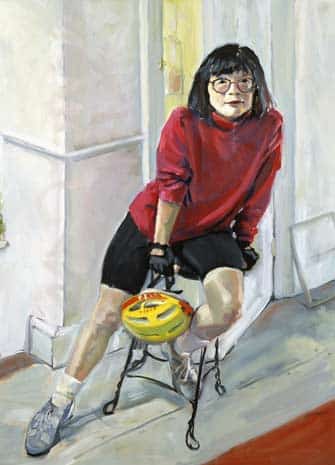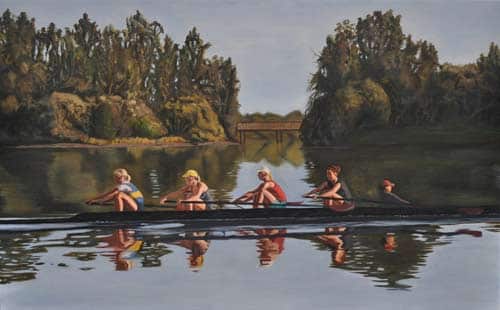by The Editors
The convergence of two events this summer brings excitement and attention to women in sports — the impetus for this edition of On The Issues Magazine on girls, women and sports. The anniversary of Title IX, which opened the way for women’s greater participation in sports in the U.S., is on June 23, 2012 – 40 years after its passage. Then, on July 27, comes the opening ceremony for the Summer Olympics in London, where an estimated 45 percent of the 10,500 athletes are expected to be female, the highest level ever.
This grand attention to women’s sports participation runs concurrent with surging interest in yoga, biking, adventuring and zumba. But, there are also undercurrents of tension, rarely discussed: What is the role of sports in our culture? How do gender “roles” play out in sports? What is the effect of media coverage and spectatorship? What is the interplay with feminism? How should sports respond to misogyny, homophobia and transphobia? Our writers and artists probe these big-picture topics, along with sharing personal narratives and stories of accomplishment and empowerment, in Level the Playing Field: Girls, Women and Sports.

©Audrey Frank Anastasi
To start things off, Laura A. Shamas reminds us that ancient history and mythology are filled with stories of women who have incredible athletic powers in Leaping, Racing, Spearing: The Female Athlete Amazes in Myth.
Policy analyst Martha Burk cuts right through ongoing objections to Title IX by showing how they are rooted in patriarchal privilege in Who Owns Sports? Dissecting the Politics of Title IX. Risa Isard reminds us of the history of Title IX, and how its role in blocking discrimination in education also put women in law, medical and graduate schools in Opening Historic Trails: Accidental Heroes Stomp Sports Inequity. Marie Hardin takes Title IX in a different direction, showing how female sports journalists owe their jobs to the knock-on effect of the law in Winning the Sports Beat: Female Writers Need Wide Angle Lens.
Several writers take us straight to the Olympics. Zerlina Maxwell recalls her childhood plan to become the next Dominique Dawes, a gold medal winner in gymnastics, and how that idea has grown up into an appreciation for women competitors in My Olympic Dream and Watching New Gymnastic Generations. Jane Schonberger, whose career blends women’s athletics with communications, takes a hard look at where the Olympics fail women – that is, in devoting similar media attention to women’s athletic talents – in Olympics’ Coverage Still Shortchanges Female Athletes.
The role of gender in sport is a constant theme of our writers. Laura Pappano, an astute observer of women, culture and sport, explains why she changed her mind about women athletes who pose in the buff in Athletes and Magazine Spreads: Does Sexy Mean Selling Out?. Andrew D. Linden, in describing the opportunities for women to play football, questions the need for the current “lingerie” league in Goalposts: Tackling the Last Bastion of Male Monopoly, while Britain’s Alex Channon explains how his investigation of martial arts showed him that sex-segregation in sports is outmoded, clinging to a need for male “superiority,” in Why Sex Segregation Is Bad for Society. And Lindsay Parks Pieper analyzes the current guidelines for transgender athletes and what’s wrong with them in Rules Put Extreme Pressure On Transsexual Players.
Susan J. Bandy traces how early feminist thinkers understood the power of women’s athletics to change the perception of all women, but academics of the second-wave often ignored women in sports. Her article, Curious Tension: Feminism and the Sporting Woman, both provokes and challenges thinking about women and culture. Rachel Toor, in a creative essay, shares her late discovery of sports as a feminist and her students’ ongoing disconnection with feminism in Nine Titles Thinking About Title IX. Lu Bailey offers a humorous review of the state of the gender divide from the moment her 10-year-old daughter decides to try out for the cheerleading team in Cheering or Being Cheered? My Daughter’s Cheerleading Adventure.
Cultural critic Ariel Dougherty thinks she might know why women’s accomplishments in sports are underestimated, and in Films Lag in Sharing The Women’s Game, says that it has to do with a slim selection of feminist movies about women’s accomplishments. Jennifer Jordan, a filmmaker and writer, explains that the awful coverage of dedicated women mountain climbers, led her to seek out the stories of the K2 women in Women On High: The Price of Passion at the Roof of the World. Tim Grainey shows us the financial miscalculations that have led to the disintegration of professional women’s soccer in the U.S. in The Rise and Fall and Possible Rise of Women’s Pro Soccer.

©Robin Hextrum
The passion for physical activities by women extends beyond traditional sports to a wide range of activities. In Yoga Frontiers: Women Shape Practices in Exceptional Ways, Molly Ginty offers a sweeping tour of women who are using yoga for personal strength, as well as to help survivors of domestic violence and rape. Eleanor Bader explores the more difficult side of athletic activities – injuries – in Bodies in Motion: Physical Females Face Different Risks.
Several writers open our eyes with their own unique and personal stories. Christine Stark, in a powerful and moving essay, explores the way she used soccer as a survival tool against sexual abuse in Becoming Glory: Kicking Goals to Transcend the Night, A Memoir. Mauricio Espinoza describes how teaching his daughter soccer helped him resolve his relationship with his father in A Soccer Dad Faces Parenting, Coaching and Dreams. Gabrielle Korn takes us to the other end of the spectrum, probing the connection between her personal dislike of sports and a discomfort about putting her body on display in Athletically Disinclined: My Counterpoint.
Extending the reach of our discussion, a reading list developed by The Feminist Press suggests illuminating books on risk-taking, wrestling and literature in Girls, Women, Sports: What to Read. We also take you to our archives in Related Stories: on Girls, Women, Sports, including articles on first-wavers, philosophy and women’s professional basketball.
As with every edition of On The Issues Magazine, we include wonderful poetry and art. Art Editor Linda Stein has featured the fascinating work of Karen Shaw in The Art Perspective. Shaw plays with gender and stereotypes by showing male athletes in newly-reworked and nontraditional garb, described in a slide display with audio. In The Poet’s Eye, Poetry Co-Editor Judith Arcana presents four poets — Kathleen Aguero, Judith Barrington, Carolyn Martin and Penelope Scambly Schott — who tell of feeling alive, high-fives, warmth and mercy. Our video arcade carries the trailer for Salaam Dunk by David Fine, about the building of a girls’ basketball team in war-torn Iraq.
And for a wry moment, we are joined in this edition by “SlowPoke” cartoonist Jen Sorensen, whose Daddyshack mocks the Augusta National Golf Club for refusing to admit women — still.
As always, we continue the conversation in our unique Café with new perspectives and stories. And we welcome your voice on Level the Playing Field: Girls, Women and Sports, as well – in comments on the stories, a letter to the editor or a Cafe submission ([email protected]) of your own. You can also sign up on our site for our updates, which are delivered in an e-newsletter every two weeks.
We hope you’ll share our wonderful collection of stories and art with your friends and colleagues. Find us on Facebook and Twitter. We have a special hash tag for this issue, too — #levelthefield.
We look forward to hearing your thoughts.
BY THE EDITORS
Also See From Our Archives: Related Stories on Girls, Women, Sports in this edition of On The Issues Magazine.
See The Poet’s Eye From Poetry Co-Editor Judith Arcana in this edition of On The Issues Magazine.
Read the Cafe for new and updated stories.
